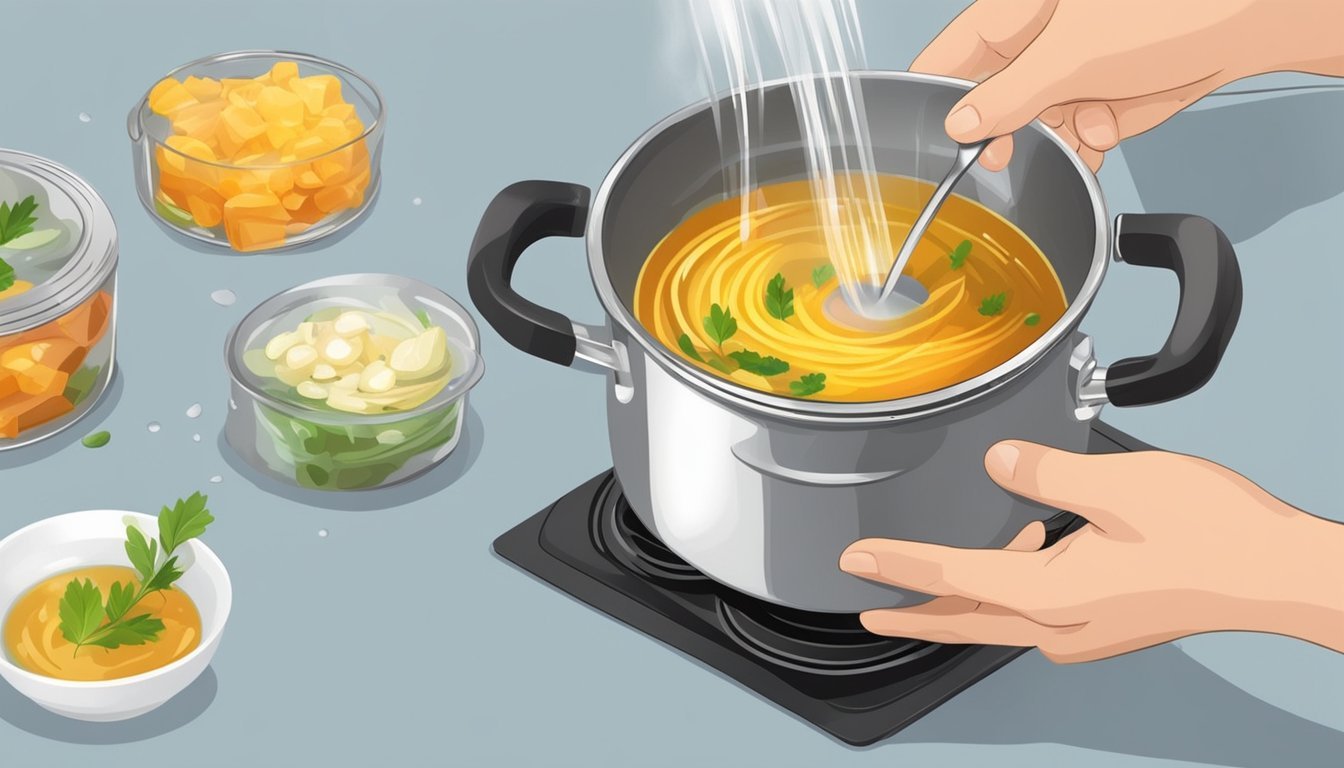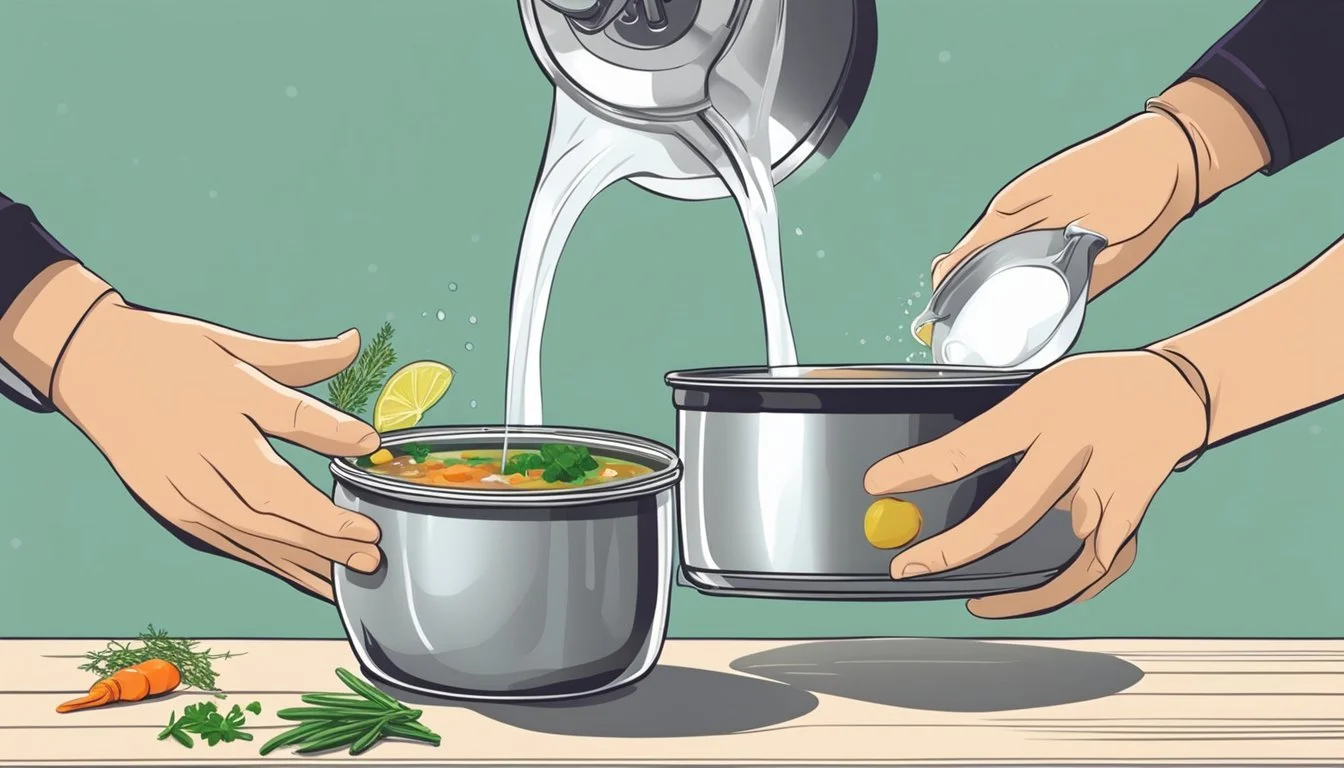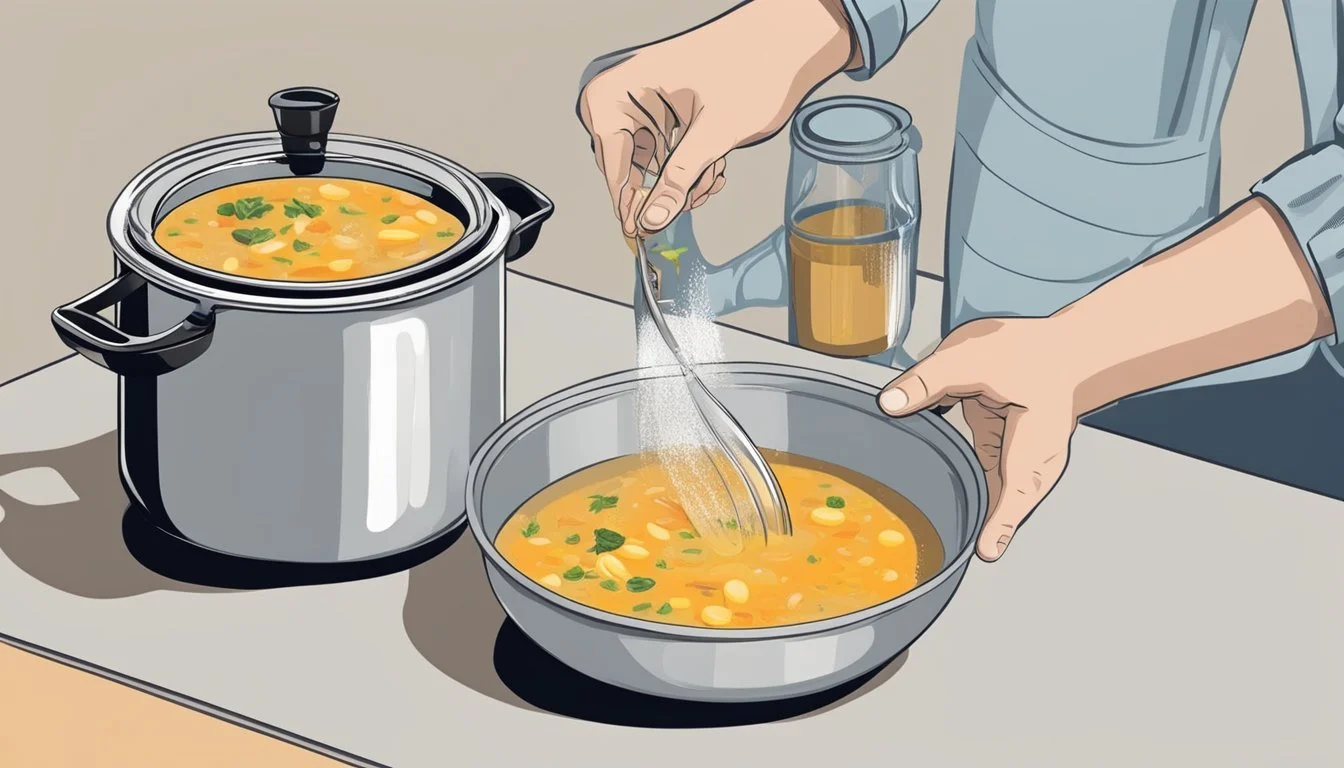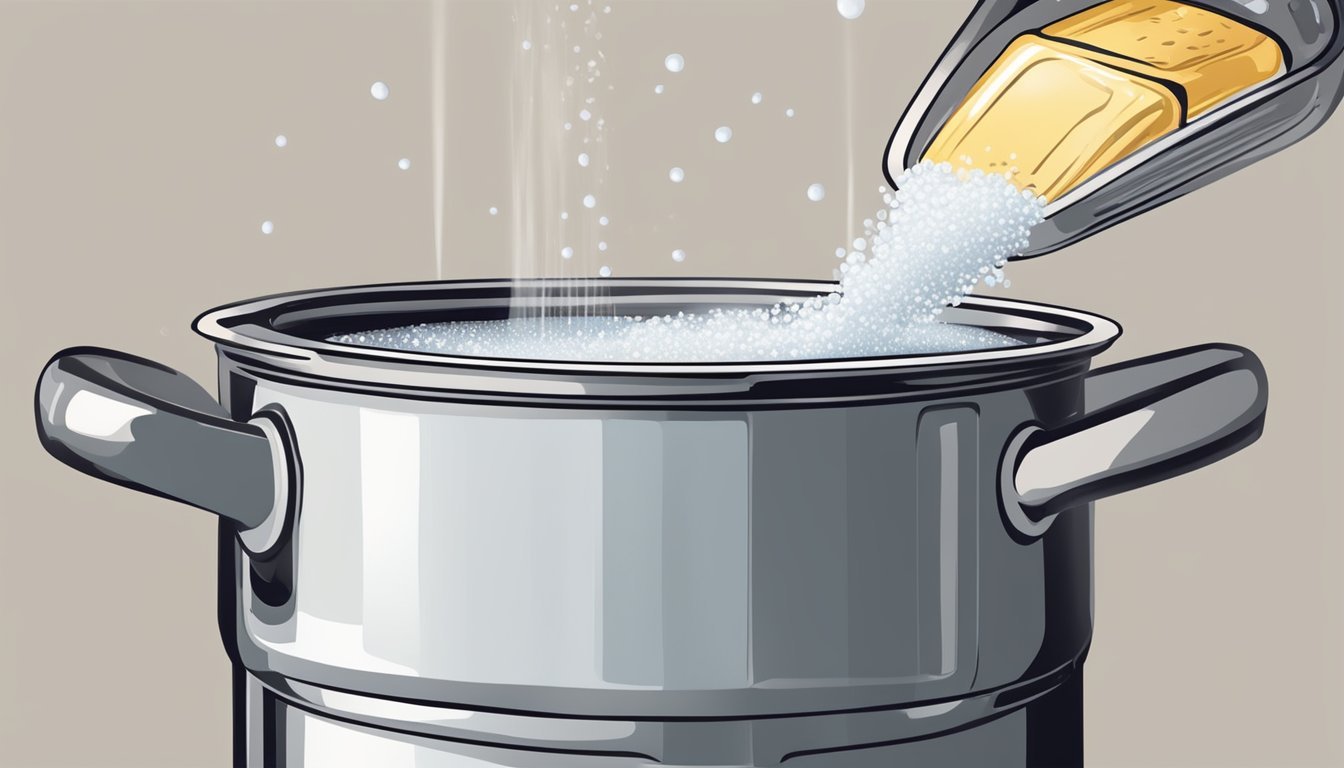Fixing Overly Salty Canned Soups
Mastering the Art of Balance
Canned soups are convenient, hearty, and often a go-to meal for those in a hurry. However, consumers frequently encounter a common issue: excessively high salt content, which can overpower the desired flavor profile and pose dietary concerns. While it might seem challenging to remedy an overly salty soup, there are practical techniques that can balance the saltiness and improve the overall taste.
To reduce the saltiness of canned soups (What wine goes well with soups?), dilution is a straightforward and effective method. Adding water, unsalted broth, or additional unsalted ingredients can spread out the concentration of sodium, making the overall dish more palatable. Beyond diluting, incorporating ingredients that counteract the saltiness can also enhance the soup's flavor complexity. Dairy products, such as a splash of milk or a dollop of sour cream, add richness, while a squeeze of lemon juice or a hint of vinegar can introduce a subtle sharpness, which shifts the taste perception.
Seasoning adjustments are another tactical approach. The introduction of spices and herbs can divert the taste buds from the salinity and bring forth a more rounded flavor profile. Introducing a garnish such as fresh herbs or a side ingredient with a complementary but distinct taste can transform an overly salty canned soup into a culinary experience that is both enjoyable and less sodium-heavy.
Understanding Salt in Cooking
Navigating through the culinary application of salt is crucial for both flavoring and preservation. Here, the reader will learn about salt's function, the differences between common salt types, and the implications of sodium in canned soups.
The Role of Salt
Salt, primarily composed of sodium chloride, is essential in cooking not only for enhancing flavor but also for its role in preservation and texture modification. It contributes to the depth of a dish, bringing out natural flavors and reducing bitterness. In the context of soups, proper salting can transform a bland broth into a savory, satisfying experience.
Types of Salt
Different salts have various textures, flavors, and culinary uses:
Table Salt: The most common type, often iodized and finely ground with anti-caking agents to prevent clumping.
Kosher Salt: Coarser grains without additives, preferred for its ease in seasoning by hand.
Sea Salt: Harvested from evaporated seawater, available in fine or coarse grains, known for its trace minerals and distinctive taste.
The choice of salt can affect the dissolution rate and distribution of saltiness in soups.
Sodium Content in Canned Soups
Canned soups are typically high in sodium, serving both as a preservative and flavor enhancer. Brands often offer "low-sodium" or "reduced-sodium" options to cater to health-conscious consumers.
Regular Canned Soups: Can contain as much as 700-900mg of sodium per serving.
Low-Sodium Canned Soups: Usually have less than 140mg of sodium per serving.
Excess sodium intake can have health implications, thus making it important to consider the sodium content when choosing and preparing canned soups.
Assessing Soup Saltiness
The key to fixing overly salty canned soups lies in accurate assessment. Discerning the level of saltiness through systematic tasting is the initial step towards an effective fix.
Initial Tasting Procedure
Before making any modifications to soup, it's imperative to determine its baseline saltiness. Taste as you go is a principle that chefs often abide by, and it applies here. One should start by stirring the soup thoroughly to ensure that the salt is evenly distributed. A small spoonful should be sufficient for the initial assessment, taking care to let the soup cool slightly to avoid scalding and to ensure the true flavor comes through.
Identifying Over-Salted Soups
An over-salted soup typically has a distinct sharpness and a pronounced salt flavor that overwhelms other ingredients. When identifying an overly salty soup, it's not just about a single taste; it's important to consider the following:
Intensity: A soup that causes one to immediately reach for water is too salty.
Balance: The taste of salt should not overpower the other flavors in the soup.
Aftertaste: An enduring salty aftertaste that lingers on the palate is a clear indicator.
Effective diagnosis is the first step in remedying a salty soup and sets the foundation for the application of appropriate diluting and seasoning techniques.
Dilution Strategies
Effective dilution methods can mitigate the saltiness of canned soups, without altering the fundamental flavors of the soup. A measured approach to adding liquids can reduce the concentrated saltiness, and expanding the soup's volume can distribute the salt more evenly throughout the dish.
Adding Liquids
Adding unsalted liquids is an effective way to dilute the soup. The cook can opt for plain water, as it does not introduce any new flavors, or use an unsalted broth to maintain a richer flavor profile. It is essential to add small amounts gradually and to taste the soup after each addition to avoid diluting the soup too much.
Water: Add in small increments, stirring and tasting to achieve the desired salt level.
Broth: Use unsalted store-bought broth or homemade broth to ensure no additional salt is incorporated.
Expanding Volume
Increasing the overall volume of the soup can help reduce the saltiness per serving. This can be achieved by adding more of the soup's existing ingredients, which have not been seasoned with additional salt.
Vegetables: Incorporate more vegetables such as potatoes, carrots, or celery.
Proteins: If the soup contains meat or beans, adding more can help disperse the salt.
Grains: Ingredients like rice or pasta can also absorb some of the excess salt.
The Water Solution
A simple and straightforward approach is using water to dilute the soup. This method requires care, as it can weaken the soup's flavor if overdone.
Hot Water: Use hot water to maintain the temperature of the soup.
Stirring: Ensure thorough stirring to evenly distribute the added water.
Ingredient Adjustments
In rectifying overly salty canned soups, one can strategically utilize additional ingredients to counteract the saltiness without significantly altering the intended flavor profile.
Incorporating Vegetables
Vegetables serve a dual purpose when adjusting salty soups—they can absorb some of the salt and also add bulk to the expanded volume of the soup. Common options include:
Potatoes: Adding diced potatoes can help to balance out the saltiness as they absorb some of the salt content.
Leafy Greens: Kale, spinach, or swiss chard contribute to a nutritious boost and can integrate seamlessly into the soup, without soaking up excess salt.
Using Starches and Grains
Starches and grains are excellent for toning down the salinity of a soup while enhancing its consistency.
Rice: A small amount of rice expands as it cooks, absorbing salty broth and thickening the soup.
Pasta: Similar to rice, pasta soaks up some of the salty liquid, which helps to reduce the overall saltiness. Use small-shaped pasta like orzo or macaroni for even distribution.
Beans: Cooked or canned beans, when rinsed and unsalted, can add heartiness and dilute the salt concentration.
Balancing Flavor Profiles
When a canned soup is too salty, adjusting the flavor profile can be an effective strategy. This involves introducing certain ingredients that counteract the soup's saltiness without compromising its taste.
Introducing Acidity
Acidity can cut through the saltiness and add a new dimension to the soup's flavor. A careful addition of vinegar or lemon juice is advised. For example:
Vinegar: A splash of balsamic or apple cider vinegar not only adds acidity but also complex undertones.
Lemon Juice: The fresh, zesty notes of lemon juice can brighten the overall taste of the soup.
Incorporating Dairy
Dairy products can mellow out the saltiness by adding a creamy texture and slight sweetness. Opt for:
Cream: A small pour of heavy cream can enrich the soup while reducing the salt's impact on the palate.
Sour Cream: Sour cream has the double benefit of adding acidity and creaminess to mitigate saltiness.
Milk or Yogurt: A moderate amount can add a tangy note and dilute the salty flavor.
Using Sweeteners
Sweetness can counterbalance excess salt without overpowering the soup's original flavors. Consider stirring in a minimal amount of:
Sugar: A pinch of white or brown sugar can neutralize some of the salt.
Natural Sweeteners: For a more subtle approach, sweeteners like honey or maple syrup offer additional flavor notes while counteracting saltiness.
Enhancing with Spices and Seasoning
When confronted with an overly salty canned soup, one can balance the flavor profile by thoughtfully incorporating herbs and spices. These seasonings add depth and complexity, diverting the palate from the saltiness.
Selecting Herbs
Herbs impart fresh and aromatic flavors that can enhance the overall taste of a soup without adding sodium. For soups with a base of vegetables or chicken, one might consider:
Basil: Sweet and slightly peppery, ideal for tomato-based soups.
Parsley: Offers a clean and subtle bitterness, which complements a broad range of soups.
For heartier soups or those with a beef base, robust herbs like rosemary or thyme stand up well. It's important to use fresh herbs when possible as they provide a more pronounced flavor than their dried counterparts.
Utilizing Spices
Spices, unlike herbs, come from the seeds, bark, roots, or fruits of plants and can offer intense and complex notes. They can introduce a new dimension to a soup that may distract from excess saltiness:
Black Pepper: Adds a sharp and woody flavor that can mask salt when used in moderation.
Red Chili Flakes: Introduce a spicy heat that can counterbalance saltiness.
Adding spices should be done judiciously, as one aims to complement the soup's existing flavors, not overpower them. Mixing spices beforehand allows one to gauge their potency before integrating them into the soup.
Heat Control Techniques
Managing heat is crucial when fixing oversalted canned soups to ensure flavors blend without further concentrating the sodium content.
Simmering Adjustments
When a canned soup is too salty, simmering it on low heat can help. This gentle cooking method allows flavors to meld without evaporating too much liquid, which could otherwise increase the salt concentration. It's important to:
Regularly taste the soup during simmering, adjusting seasonings as necessary.
Avoid boiling, as this can reduce the liquid and make the soup saltier.
Sautéing Components
Before adding any components to the soup, sautéing them can enhance their flavors and introduce new taste dimensions that may balance out the excess salt. Here are specific points to consider:
Sauté vegetables like onions or garlic before adding them to the soup. This caramelization brings out their natural sweetness, providing a counterbalance to the saltiness.
Use unsalted butter or oil to prevent adding more salt into the mixture.
Fixing Specific Soup Types
When addressing the saltiness in canned soups, different types of soups require unique approaches due to their ingredients and consistency. Here we explore how to adjust chowders and correct tomato-based soups without compromising their intended flavors.
Adjusting Chowders
Chowders, often rich and creamy, can handle the addition of dairy to counteract excess salt. One can stir in milk or cream, allowing the dairy to meld with the soup without altering the texture significantly. If the chowder is seafood-based, adding more unsalted fish or shellfish stock can also effectively reduce saltiness, enhancing the stew's (What wine goes well with stews?) natural flavors without dilution.
Correcting Tomato-Based Soups
Tomato-based soups, like classic tomato soup or those containing canned tomatoes, benefit from a careful balance of acidity and sweetness. A pinch of sugar may counteract the salinity without making the soup overly sweet. Additionally, increasing the volume with additional canned tomatoes—preferably no-salt-added varieties—helps to balance the taste while maintaining the robust tomato flavor.
Prevention and Recovery
In addressing overly salty canned soups, one must recognize both the preemptive strategies to avoid over-salting and the reactive measures to fix salty soup. These are critical in retaining the palatability and nutritional value of the meal.
Preventing Over-Salting
When using canned soups, individuals can take proactive steps to prevent over-salting. It's essential to:
Read labels carefully: Opt for low-sodium or no-salt-added versions to better control the overall salt content.
Taste before seasoning: Even if convention suggests adding salt, one should first taste the soup and season accordingly.
Recovering Oversalted Soups
If a canned soup is already oversalted, there are several techniques to fix salty soup:
Dilution: Add unsalted broth, water, or another liquid to the soup in small increments, tasting after each addition.
Bulk up: Incorporate additional ingredients that do not contain salt. Items like unseasoned cooked rice, pasta, or even diced potatoes can help absorb some of the salt.
Use dairy judiciously: A small amount of milk, cream, or yogurt can balance the salty taste, especially in creamy soups.
Acidity: A slight squeeze of lemon juice or a splash of vinegar can sometimes tone down the perception of saltiness, but one should use this with caution to not alter the soup's intended flavor profile dramatically.
Practical Tips for Home Cooks
When attempting to correct the seasoning of overly salty canned soups, a cook must possess both proactive and reactive strategies. The former involves initial taste assessments, while the latter requires the ability to adjust and balance flavors appropriately.
Taste as You Go
One should always taste their food throughout the cooking process, especially when trying to integrate canned soups into homemade dishes. This allows for incremental adjustments before flavors become too concentrated. Tasting as you go also offers insights into how various ingredients affect the soup's overall flavor profile.
Steps for Tasting:
Start with a small spoonful: Be cautious of the temperature.
Assess and identify: Pinpoint if the saltiness is mild, moderate, or severe.
Incremental adjustments: Based on your assessment, decide what intervention, if any, is needed at that stage.
Kitchen Skills Enhancement
Enhancing kitchen skills is crucial for correcting oversalted soups and creating successful homemade versions.
Skill Enhancement Techniques:
Dilution: Learn to gradually add water or low-sodium broth to the soup, ensuring not to overdo it to avoid watering down flavors.
Balancing flavors: Incorporate a splash of acid, like lemon juice or vinegar, to counteract the salt without altering the soup's intended taste.
Ingredient knowledge: Understand how various ingredients, such as dairy or starchy vegetables, can mitigate saltiness and contribute to the texture and richness of the soup.
By honing these techniques, one can confidently address overly salty canned soups and perfect the art of homemade soup-making in their kitchen.
Advanced Considerations
When attempting to correct the saltiness of canned soups, one must consider the intricate chemistry of salting and the impacts on various dietary restrictions. These advanced considerations require a thoughtful approach to maintain the balance of flavor while respecting health constraints.
Chemistry of Salting
The process of correcting salinity in canned soups hinges on understanding the chemistry of sodium and its interaction with other compounds. Sodium chloride (NaCl), the chemical name for salt, enhances the flavor profile of food by balancing and bringing out other tastes. To mitigate excessive saltiness, one could introduce ingredients that counteract sodium's effects without altering the desired flavor. These include:
Water or Unsweetened Broth: Dilutes the overall sodium concentration.
Acids: Such as vinegar or lemon juice, which can provide a taste contrast that may make the soup taste less salty.
Compound Role in Balancing Saltiness Water/Broth Dilutes sodium concentration without adding flavor. Acids Offers a contrast that can make the soup seem less salty.
It's integral to add these ingredients judiciously, as they can alter the soup's intended flavor if used excessively.
Adjusting for Dietary Restrictions
For individuals with dietary restrictions, reducing the salt content in canned soups is not only a matter of taste but also of health.
Low-sodium Broth: For those on a sodium-restricted diet, using low-sodium broths can help dilute the saltiness without adding more sodium.
Dairy Alternatives: A swirl of coconut milk or unsweetened almond milk offers a way to temper saltiness for those avoiding dairy or lactose.
Dietary Restriction Suggested Seasoning Adjustments Sodium-restricted Utilize low-sodium broths for dilution. Dairy-free Opt for non-dairy alternatives like coconut milk.
Choosing seasonings and dilution methods should account for these restrictions to ensure the soup remains both palatable and compliant with dietary needs.
Conclusion
Fixing overly salty canned soups can be straightforward with the right techniques. Diluting the soup is often the quickest method. Adding water or an unsalted stock can effectively reduce the salt concentration. However, one must be cautious not to overly dilute the soup, which can lead to a loss in flavor.
Dairy can serve as a rescue ingredient for creamy soups. A swirl of cream, milk, or yogurt can mellow the saltiness while adding richness. Dairy products should be incorporated gradually and tasted often to achieve the desired balance.
Introducing additional ingredients that absorb salt, such as rice or unsalted pasta, can also correct an imbalance in seasoning. When using this approach, one should monitor the soup's texture to prevent overcooking the added components.
Here's a quick reference:
Technique Ingredient Effectiveness Dilution Water/Unsalted broth High Dairy Addition Cream/Milk/Yogurt Medium Absorption Rice/Pasta Medium
It is essential to remember that while these techniques can save a dish, prevention is always better than correction. Reading labels carefully and being mindful of the salt content in canned soups can help avoid oversalting from the start. Additionally, tasting the soup before serving allows for adjustments to be made in a controlled manner, ensuring a well-seasoned final product every time.







